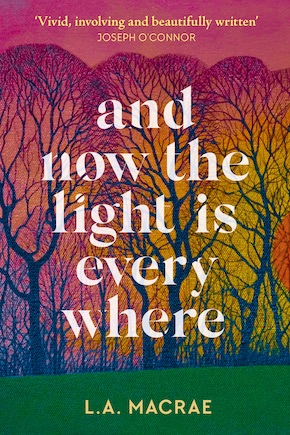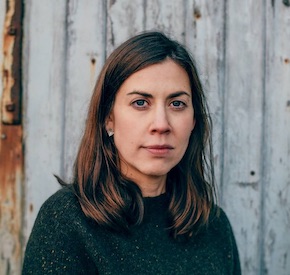Tell me a story
by L.A. MacRae
Our oldest memories are in stories. Our oldest memories are stories. To tell a story well is a skill: the sort that can be learned but cannot easily be taught. To be told a story is a pleasure and often a privilege. When I first picked at the thread of an idea for my debut novel And Now the Light Is Everywhere, I imagined a tale told in many voices, where the stories slowly reveal a hidden, deeper tale: a truth that blooms slowly like a sunrise, until the light – well, until the light is everywhere.
I was working at the School of Scottish Studies in Edinburgh when I started writing, and so had the chance to dig through the amazing sound archives housed there, listening to stories, songs and poems collected around Scotland since the end of the Second World War. As a Gaelic speaker and traditional musician who grew up between Fife and Argyll, I have always had a deep fascination with Scotland’s folklore, but as well as the material itself I always wanted to know about the people behind the voices: those who had given up their time to be recorded, and those who recorded them, on wax cylinder in the early days, and later on reel-to-reel tapes. I loved to imagine the likes of folklore collectors such as Margaret Fay Shaw, Calum Maclean or Hamish Henderson turning up at doors in South Uist, Aberdeenshire, Orkney: often unannounced and brandishing a recording device. But what tales, I wondered, were left untold when the tape was running, picking up budgies chattering in cages, chiming clocks and muffled doorbells signalling long-forgotten visitors? What did the stories mean to those who were telling them, and what was left untold?
I knew I wanted to write a novel which touched on these questions. One evening, walking my beloved late lurcher along a rutted farm track in Argyll close to where my father lives, the idea started to take root. I remember looking at the nettles growing up thickly on either side of the track and thinking of what I’d been told about nettles growing in the old ruins of abandoned villages and farms my father had taken me to as a child. The richness of the soil that human habitation left behind turned to something tough and resilient, but also to be approached with care, like a family history. I spent a lot of my childhood in Argyll. My father was a great one for visiting the older folk in the community, a generation which is entirely gone now. Poets and mechanics, war veterans, hill farmers, forestry workers who had worked with the big horses before the machines came in: all had stories to tell, and they left an enduring impression, not unlike the ancient stone footprint to be found at the fort of Dunadd, said to be the crowning place of kings. Argyll’s landscape is “sown with stories”, as I write in the novel, and yet the area has an edge to it as well, showing itself in the accent, a blend of West coast with a touch of Glasgow that is unique.
I wanted the book to have these touches of the past in it, sometimes not fully explained – the slightly uncanny experiences that two of the characters have, for example, which have their echoes in tales of remote places: the man Netta meets on the hill as a young teenager who gives her a pearl, and the strange experience Mary Rose has of being pushed out of the way on a hill path by an unseen crowd just before her first fateful meeting with Donnie. These two occurrences are inspired by folktales: the meeting with a fairy lover, told I’m sure as a warning to young women alone in isolated spaces, and stories of the second sight, where someone will experience an invisible funeral procession as they unknowingly walk a ‘coffin road’ some time before a death occurs in the community.
Poets and mechanics, war veterans, hill farmers, forestry workers who had worked with the big horses before the machines came in: all had stories to tell, and they left an enduring impression.”
I love researching history almost as much as I love stories, and started to write this novel by outlining a huge family tree. Perhaps because I had spent so much time in archives during my academic career, it seemed like a natural place to start. I wanted to be able to see the connections as well as the waifs and strays.
Or perhaps that wasn’t the reason at all. Perhaps it was because of a large black family bible I stumbled on – literally – in one of Edinburgh’s extraordinary old second-hand bookshops. Intrigued, I opened the cover of this massive tome, the size of a small suitcase. On the first page, the births and deaths of several generations had been recorded. I stared at that list of names for some minutes, and my mind wandered to those not recorded: the outcast, the distanced, the tail ends and afterthoughts crossed out or obscured like a smudge from the records.
That evening, Netta MacArthur’s voice and the words that were to become the first line of And Now the Light Is Everywhere came clearly into my head. They stopped me in my tracks and demanded to be written. As I began to write, I found that I was telling the story of a family over time: each in their own present, with the reader moving through the generations as the consequence of one life impacts upon another.
“You can’t live in the past,” protests my main character Anna MacArthur to folklore researcher John Teelin in the novel. “Like it or not, the past lives in you,” is his reply.
It is this kernel of story, of past lives that we all carry within us, that I hope to have brought to And Now the Light Is Everywhere, with its recurring themes of repression, freedom and endurance uncovering vanished lives and illuminating the evasive nature of truth.
—

L.A. MacRae was born in St Andrews and brought up on the coasts of rural Argyll and the East Neuk of Fife. After living in the Outer Hebrides and the south of Ireland, she worked at Edinburgh University’s School of Scottish Studies, researching oral history and traditional music. She lives on the Isle of Skye. Her debut novel And Now the Light Is Everywhere was longlisted for the Caledonian Novel Award 2021, and is published by Hodder & Stoughton in hardback, eBook and audio download.
Read more
lamacrae.com
l.a.macrae
@HodderBooks
Author photo by Archie MacFarlane

